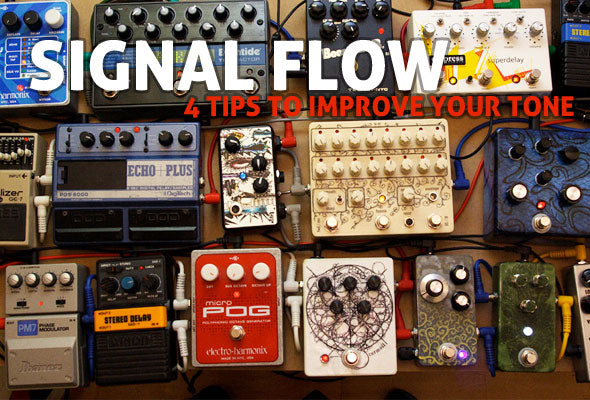Get Better Tone: Pedal Board Upgrades And Tips

Pedal Board Signal Flow: Essential Upgrades and Tips For Improving Your Tone by John Oliva
When I was a kid I always wanted to know how to sound like the pros. Was it really just a guitar, just an amp getting that tone? Not always. Effects and their tasteful use within a song can be key to chasing down the tone of your dreams.
While working at The Music Zoo I’ve learned that a lot of our customers aren’t always aware of some of the great “make life much easier” tricks, components and effects available to them. Every player is different and their ears and tastes are subjective, but everyone usually agrees on one thing: they want to sound the best that they possibly can. Here is a list of a few things that I have found to be essential to improving the great tone that you already have. Please keep in mind that these are my opinions and suggestions, please take them for what they are worth. There are no sales plugs here, just things that have been helpful to me.
1. Get some good cables. I was skeptic for years. My motto was “if it ain’t broke don’t fix it.” Finally I decided to listen to what other guitar techs and players had to say about nicer cables, and I bought some Mogami gold cables. My attack, signal speed and overall clarity was noticeably improved. I couldn’t believe what I had been missing. These cables tightened the bond that I already had felt with my instrument. Whatever brand works best for you, if you are using those same old cheap cables you’ve had forever, look into upgrading to high performance cables. This goes the same for your pedal connectors. You will notice a difference.
2. Using True Bypass Loopers – Are you having trouble when you get to the part of the song where you have to turn on the flanger and hit your distortion pedal at the same time? Fear no more. There are many affordable true bypass loopers that easily allow you to group effects to a master switch to turn them on and off. When the switch is deactivated, your signal bypasses your effect pedals. This is important because lots of pedals on the market are not true bypass or have a buffered bypass, in which your signal must run through that pedal’s electronics before reaching its output point. This will result in very little to very noticeable amounts of “sound coloring”, natural compression, and signal degradation. Even the simplest pedals boards consisting of a tuner, wah pedal and overdrive can degrade your signal. Grouping and looping your effects will not only eliminate this problem entirely, but open the possibility of turning on multiple effects at once in an analog platform. The second advantage here is now having the ability to use two effects at once that may not sound so great on their own, but sound awesome together. For instance, My Wampler Plextortion sounds great through my Fender combo and gives me that mean British distortion tone, but when I add an EQ and a boost, my tone shapes up considerably and the boost gives the sound a thicker, more upfront attack. I could never turn all three on at once, hence my bypass looper doing that work for me.
3. Quality Power Supplies – While the 1 SPOT adapter and other daisy chains are great for “throw and go” pedal setups, power supplies with independent outputs will help eliminate noise and ground loops while giving you a clear view of its independent wiring. Part of keeping your sanity and saving yourself from embarrassment on stage is also being able to identify a problem or bad connection as fast as possible. If all your effects are grouped together on one strand of power going into the power strip, it will be harder to quickly diagnose a problem.
4. Signal flow – This is a biggie. Think about the order that your signal runs through your board from guitar to board to amp. The order in which the your instrument’s signal moves through the effects plays a huge role in the overall sound you’ll achieve. As a starting point, place all of your effects down on your board where they will be easiest for you to access. Then wire them in the firing order that will allow them to complement each other. My board runs in this order – Custom Distortion box > 4 button looper (Loop 1 – Plextortion and EQ, Loop 2 –Fuzz and Phaser used together, Loop 3 – Rotary Pedal, Loop 4 Boost, Reverb, Tuner) That all comes out to an Analog Delay. This allows me to have multiple dimensions of distortions and fuzz, the ability to boost everything, delay everything, phase everything, and reverb everything. If I had my verb before my distortion, my signal would be getting to that pedal weaker and effected, and the distortion may not be as sensitive as it should. If you get them all in the right order, you will notice how well everything can work together, and you can spend some time building your layers of tones. Make sure that you don’t boost to early in the chain, or add delay too early. Keep in mind that different combinations of pickups, effects, and tubes are going to affect each other, so when you try out new pedals in the shop try to match pickup outputs and amp/tube configurations to what you have in your personal setup to ensure that the pedal will perform how you want in your rig.
I hope you find this article informative and helpful. If you have any questions or want some pedal suggestions, feel free to email our sales team or give us a call. Thanks for reading.





